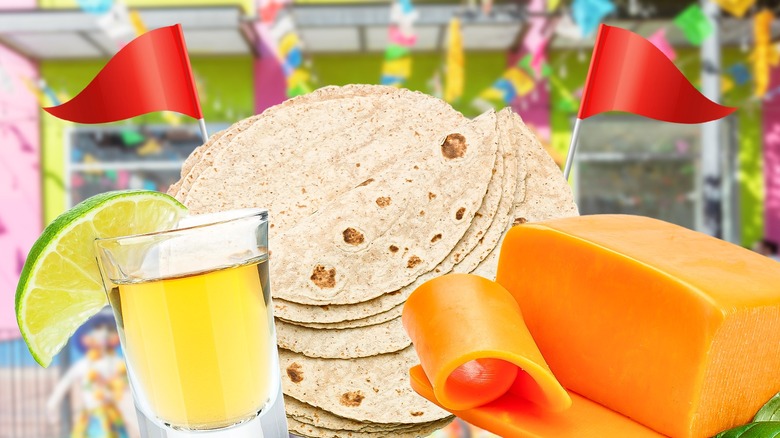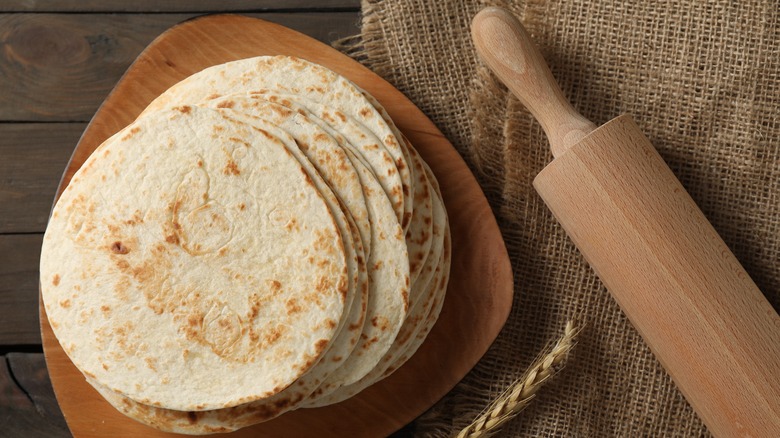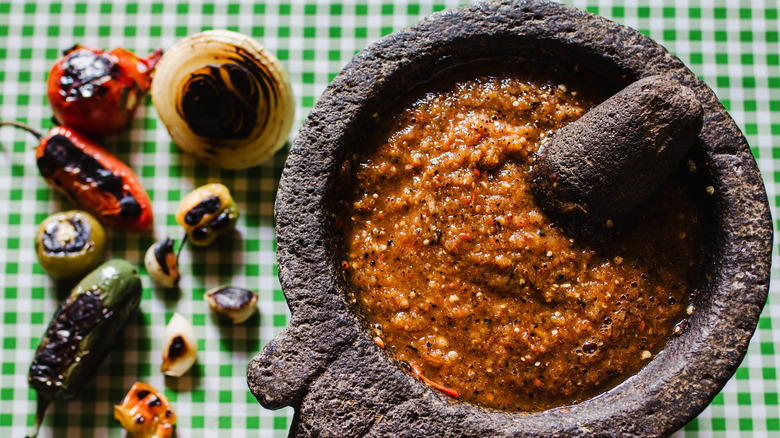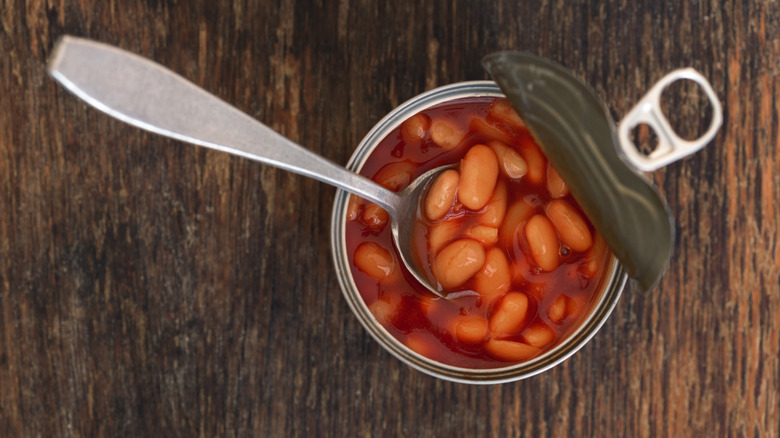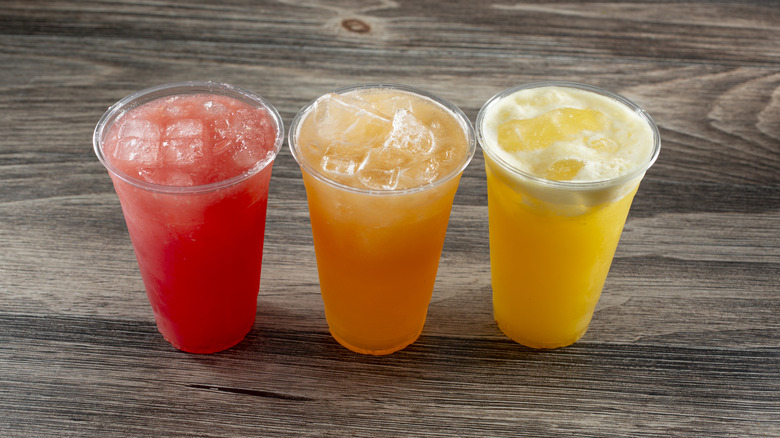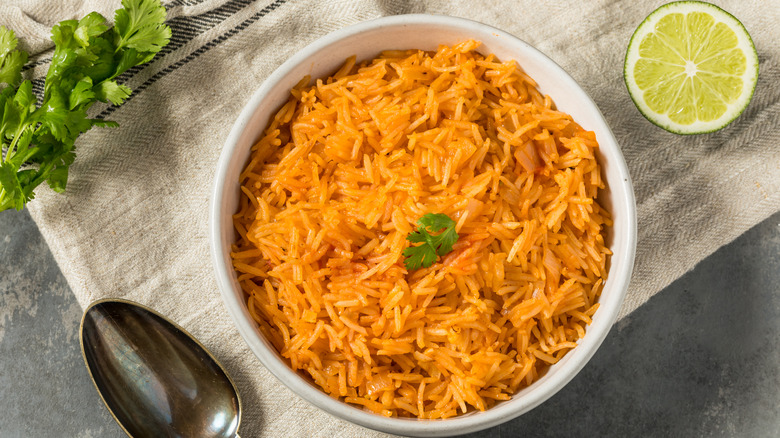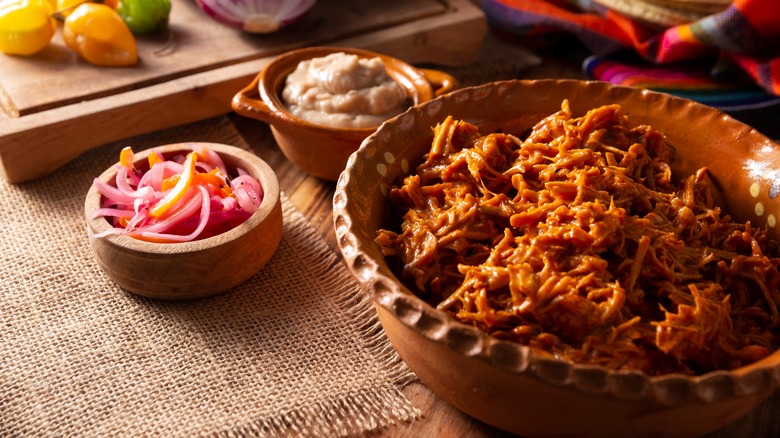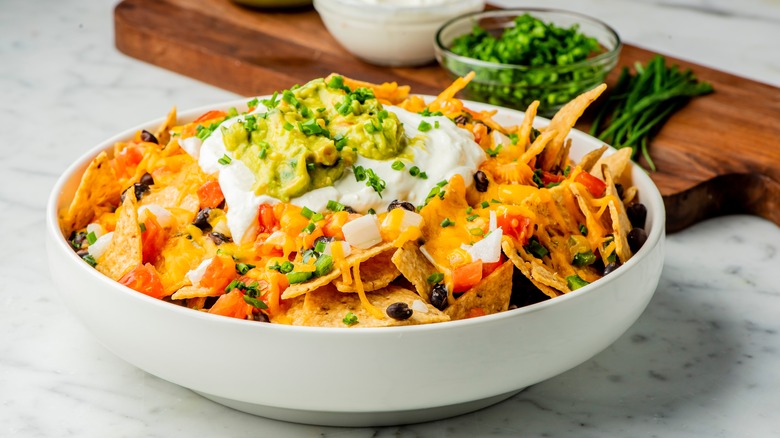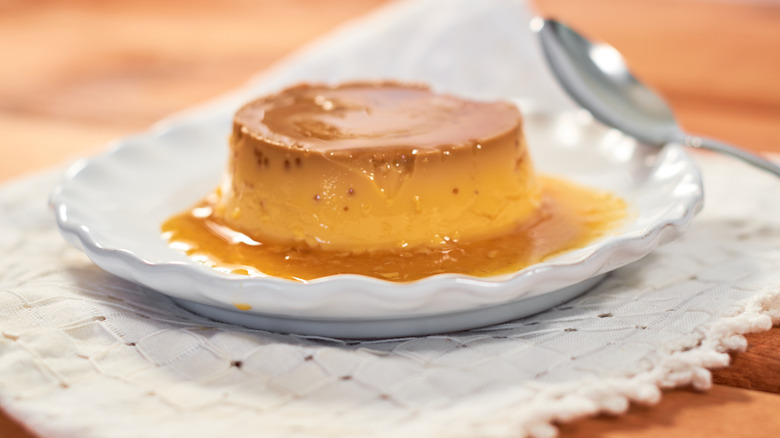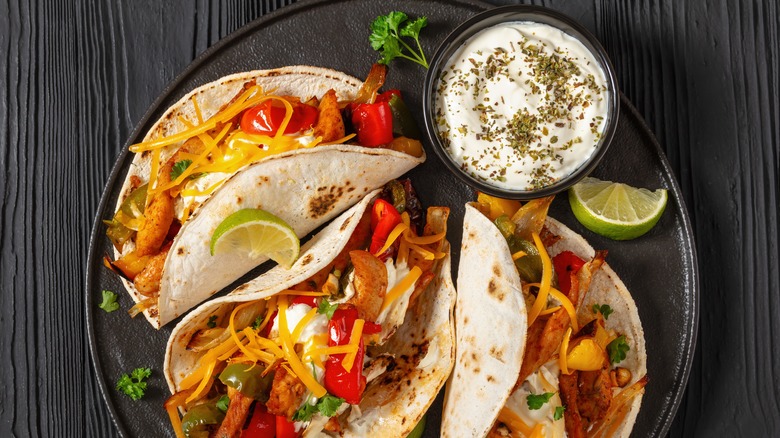10 Red Flags That Pros Know Mean A Bad Mexican Restaurant
Mexican cuisine is hearty, bold, and colorful, and it earned a place on UNESCO's Representative List of the Intangible Cultural Heritage of Humanity in 2010. Yet, these ancestral Mesoamerican techniques and distinct regional specialties aren't always respected in self-proclaimed "traditional" restaurants around the world. Corn, tomatoes, nopales (prickly pear cactus), beans, and queso fresco are some of the essential ingredients needed for Mexican cooking, and once gathered, you can easily prepare your own flavorful and fun feast at home. Nonetheless, should you prefer to enjoy those mouthwatering dishes and drinks at an "authentic" venue, there are many elements to look out for to avoid being robbed of a pleasant and genuine experience.
Here is a selection of red flags that could make you question a Mexican restaurant's know-how and professionalism, according to Miguel Martín Gómez, the well-traveled chef and owner of Colíma Cocina Mexicana in Amsterdam. Additional insight is provided by Tom Gilliland, the award-winning co-founder of Fonda San Miguel in Austin. So, hold that tequila shot ritual and keep your eyes peeled for those cheddar-smothered appetizers, canned tomatoes, and beef fajitas.
1. Only wheat tortillas are served instead of corn
A tortilla is a soft and circular flatbread that is an inherent part of Latin American cuisine, and in Mexico, the dough is commonly made from maize (corn). Corn was first developed in Central Mexico over 7,000 years ago from a wild grass called teosinte, which displayed small kernels. Other food crops that may have originated in Mexico include amaranth, chia, agave, squash, and certain species of chilis.
While a Mexican restaurant certainly may offer both corn and wheat flour tortilla options on its menu, it's the total absence of the former that should raise the alarm. Gómez is uncompromising about it: "Corn is the foundation of Mexican food. No corn tortillas? No, thanks," he says. Despite finding flour tortillas to be acceptable, he goes on to point out, "... Wheat is more neutral and has very little flavor, whereas corn has a significant impact on a dish's flavor and structure."
According to Colíma's menu, the tortillas Gómez serves are delivered several times a week and are made fresh from only heirloom, non-GMO corn that is imported from farmers in Mexico. They're produced at an artisanal tortilleria in Aalsmeer through a difficult and lengthy ancestral process called nixtamalization, which Gómez notes is authentic Mexican cuisine's first building block.
2. The absence of homemade salsas
There are many types of Mexican salsa, from taquera, which includes charred or boiled chiles and tomatoes; to roja, which only uses fresh chiles; and macha, which is loaded with ground nuts and seeds. So, imagine the disappointment when you're at a Mexican restaurant and realize that the bland sauce you're dipping your protein into is glaringly store-bought and contains artificial ingredients that leave a weird aftertaste.
Gómez insists that a minimum of three homemade salsas should be offered on the menu and that at least two of them should be spicy. "It's just the way it's done in Mexico, and it's part of the culture," he adds. Gómez personally uses a combination of fresh and dry chili peppers, and all of his restaurant's salsas are tatemadas. "That means you first burn the vegetables in a pan before adding liquids like water or oil, which gives them a smoky undertone," he explains. Some of Gómez's key ingredients include fresh red tomatoes, fresh green tomatillos (a type of sour green tomato that is widely used in Mexico), as well as fresh habanero peppers, which are known for their potent combination of spicy, sweet, and tart flavors.
3. Fresh quality ingredients seem scarce
While preparing a Mexican-themed feast at home, people often resort to canned Mexican foods like black beans, salsa verde, salsa roja, huitlacoche (corn mushroom), diced tomatoes, and nopales. Rather than prepare everything from scratch and scout for ingredients that may not be in season, it's much more practical to run to a specialty store and stock up on renowned brands like Juanita's Foods, Doña Maria, Herdez, San Miguel, or El Mexicano. Nevertheless, a quality Mexican restaurant should make the effort to mostly use fresh or premium ingredients. This should especially be the case when it comes to items that are a fundamental part of Mexican cuisine, such as cilantro, oregano, tomatoes, onions, beans, pork, peppers, and prawns.
For his part, Gilliland says that he particularly dislikes the prevalence of "chips and salsas that taste store-bought and are rarely replenished," not to mention the lack of freshly squeezed lime juice in the preparation of margaritas. Yes, bottled lime juice is certainly convenient, but fresh lime would elevate any drink and add more zest and brightness.
4. A lack of authentic Mexican drinks
Mexico boasts a rich cocktail culture and a wide array of alcoholic and non-alcoholic drinks. These range from top-selling beer brands — like Corona, Pacifico, Sol, and Victoria — to agave-based spirits, like tequila and mezcal. Sotol, made from the desert spoon plant, originated in northern Mexico, while the partially fermented, pineapple-based tepache dates back centuries. Also typically consumed are aguas frescas, non-alcoholic beverages made from fruit, cereal, flowers, and/or seeds, and sweetened with sugar.
Any Mexican restaurant with claims of authenticity would do well to propose a decent choice of several of the abovementioned drinks. Per Gómez, "A lack of Mexican drinks on the menu ... is a clear sign of a lack of authenticity." As an example, he adds that restaurants should at least make the effort to feature some of Mexico's celebrated mezcals in order to honor this aspect of the country's cultural heritage.
While we're still on the subject of drinks, Gómez isn't too fond of the recurrent salt, lime, and tequila ritual at some joints either. Noting that it's a sign to avoid an establishment, he explains, "Tequila (and mezcal) is one of the most sophisticated distilled spirits, and whilst it's okay in a shot, it's preferable to sip it. Salt and lime are only necessary if the quality of the product is low."
5. No Mexican-style rice or the Morelos variety
Rice is a staple food in many traditional and fusion dishes, from India to the Middle East, and the beloved and ever-evolving Chinese American cuisine. Rather than only serving bland, steamed white rice, authentic Mexican restaurants would do well to also propose arroz rojo, or red long-grain Mexican-style rice. The latter pairs well with enchiladas, tacos, grilled chicken, and fried fish, among other items. First sauteed in oil until golden, it gets its reddish color from being cooked in fresh tomato juice, and its intense flavor from chicken broth and fresh garlic gloves.
On another note, patrons looking to experience authentic Mexican cuisine would certainly appreciate chefs using a renowned variety of rice called Morelos, so valued that it's federally protected. Its thickness and fluffy texture render it a local favorite in both savory and sweet dishes, including arroz rojo and agua de horchata, a sweet rice milk beverage that is mostly popular in Central Mexico.
6. The menu doesn't feature regional dishes
While many traditional appetizers and main courses are commonly consumed all over Mexico, there are also a plethora of state, regional, and municipal dishes that may be worth sampling — or listing on your menu. These specialties feature enticing and potent star elements and are passed down for generations, if not centuries. They include southern Mexico's pozol, a fermented, cocoa-flavored corn drink; Yucatán's achiote spice; and Oaxaca's fried-corn empanadas con flor de calabaza, which are stuffed with cheese and squash blossoms. Oaxacan gastronomy is also famed for its black mole sauce; tlayudas, or very thin cheese and lettuce corn tortillas; and queso Oaxaca, a semi-soft, low-fat cheese. Guadalajara, the center of the North Pacific Coast, is known for birria, a pork, beef, or mutton stew marinated with chili peppers. Cotija, in the state of Michoacán, has a cheese named after it, while El Bajio's delicious contributions include cajeta, or goat's milk caramel sauce.
According to Gilliland, for added credibility, even the wait staff of a seemingly traditional Mexican restaurant should familiarize themselves with the country's seven culinary regions. He also deplores the fact that many professionals seem to mistake Cancún for a region, while it's actually a city on the Yucatán Peninsula.
7. Too much cheddar and other non-Mexican cheeses
Originating in England but produced all over the world, cheddar cheese can be mild, sharp, or particularly biting, depending on its aging process, seasoning, and country of origin. Whether shredded or melted, the milder variety, as well as the California-born Monterey Jack, is very popular at Tex-Mex joints and taco stands across North America. They're especially used in quesadillas, fajitas, nachos, and burritos.
However, you're less likely to find cheddar and Monterey Jack in authentic Mexican appetizers and dishes, mainly because there is a slew of national and regional varieties that would suit these specialties better. Common traditional cheeses include queso fresco, Cotija, and queso Chihuahua. Queso fresco, Spanish for "fresh cheese," was created in the early 1800s. It is mildly acidic and turns very creamy when heated, which makes it ideal for enchiladas, for example.
As for Cotija, named after a wooded town nestled in the state of Michoacán, it was likely popularized by Spanish settlers. Produced from cow's milk, this crumbly, salty cheese is particularly suited for chilaquiles, salads, tacos, and grilled vegetables and meats. Finally, the state of Chihuahua boasts a titular queso that was originally introduced by Mennonites in the 1920s and is mostly used in dips and toppings. It's soft, buttery, and available in balls, rounds, and braids.
8. Too many mariachis and an over-the-top décor
Mexico conjures up many culturally, historically, and artistically significant symbols and emblems, from the colors red, blue, green, and orange to the broad-brimmed felt or straw sombrero, the national flag's eagle and prickly pear cactus, and the colorful and elaborate Day of the Dead sugar and flower skulls. While these elements are all part of the heritage, an aggressive abundance of them at a Mexican restaurant could very well annoy — and drive away — potential clients. We're talking about a profusion of hanged serapes, stickers of funny cartoon characters, and giant portraits of controversial artist Frida Kahlo and contemporary celebrities like actor Salma Hayek.
Gómez, for one, would refrain from setting foot in a venue featuring this type of over-the-top décor, including mariachis and several colored paper banners. Known as papel picado, those cut paper banners are traditionally displayed during meaningful occasions and events. Each color is supposed to represent a feeling: Purple, for instance, denotes grief, while yellow celebrates the sun, and white means hope. Therefore, they probably shouldn't all be randomly and perpetually lumped together as a supposedly "quaint" part of a restaurant's décor.
Similarly, moderation is also recommended when it comes to the above-mentioned mariachi bands. These groups are meant to represent Mexico's passionate and pleasant ranchera music — not sing unnecessarily loud harmonies while strumming the guitarrón around tables.
9. The restaurant doesn't offer traditional desserts
Concluding a hearty meal at a Mexican restaurant with a typical dessert or pastry is always a tempting idea, provided that the item in question truly represents the best that this rich culture has to offer. It doesn't even have to be an elaborate recipe, as there is a large selection of treats to satisfy that sweet tooth. For instance, tres leches cake — Spanish for "three milks" — needs evaporated, condensed, and whole milk, all commonly found in almost every pantry. There is also the comforting, cinnamon-flavored arroz con leche, or rice pudding; the ever-popular caramel flan; chongos zamoranos, based on egg yolks and curdled milk; and paletas, the Mexican answer to popsicles, typically made with fresh fruit and condensed milk.
As for Gómez, in order for his restaurant to stand out, he's refrained from serving the all-too-familiar tres leches. The current desserts on his menu include pastel de elote — a flourless cake made with sweet corn kernels and condensed milk, which is consumed all over Mexico — as well as his own twist on arroz con leche. Restaurateurs have so many options to choose from; there is arguably no excuse to exclusively serve non-Mexican desserts that can just as easily be ordered at any international joint.
10. It's a Tex-Mex joint posing as authentic Mexican
11% of U.S. restaurants serve Mexican food, per Pew Research Center. Some of the most popular Mexican restaurant chains include Taco Bell, Wahoo's Fish Taco, and Baja Fresh, but they probably don't employ ancestral methods or exclusively use ingredients sourced and produced south of the border. Though it's a tasty and wide-ranging category in its own right, Tex-Mex differs from typical Mexican gastronomy in many ways. The predilection for wheat tortillas, chili in powder form, yellow American cheese, loaded nachos, and beef first springs to mind.
When it comes to red flags ruining a so-called Mexican restaurant, Gilliland makes note of "the absence of menu items that only the most fluent Spanish-speaking person can pronounce," using crema de calabaza mantequilla con chile ancho as an example. The use of the word "fajita" is also a red flag. "What I refer to as 'Frankenstein' recipes too often serve as a warning that a Mexican restaurant will be disappointing," Gilliland adds. "These unnecessarily complex recipes muddy the public's — and that of some critics' — understanding and expectation of authentic Mexican food offered in American restaurants."
It is, indeed, a shame when a venue pretends to serve traditional specialties and deprives its patrons of a genuine and enriching culinary and cultural experience. Keep these points in mind the next time you walk into a heavily decorated place that's drenched in colored paper banners and pushes flour tortillas loaded with cheddar cheese and canned refried beans.
